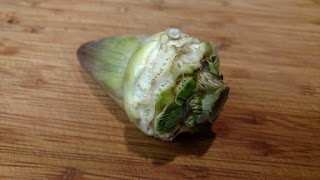
Recipe: How to make the most of these bonus babies
 |
| "Baby" artichokes are just petite full-grown artichokes. They can be used in all kinds of recipes. (Photos: Debbie Arrington) |
It’s been a great spring for artichokes. In Sacramento gardens, these oversized thistles have been especially productive, pumping out gobs of globes.
But what do you do with all those “baby” artichokes? Preparing these bonus babies takes work, but they’re all heart.
 |
| All those baby artichokes are actually fully developed and mostly heart. |
These small side buds aren’t actually “baby” artichokes; they’re fully developed, just petite. The good news: Most of them contain little if any choke – those prickly hairs that cover the meaty heart.
An abundance of small artichokes drove me to look for ways to prepare and save them for later. (Italian cooks have been doing this for centuries.) Here are some short cuts:
When cut, artichokes turn black quickly. To keep them green, set up a large bowl of water. Cut a lemon in half. Add the juice of one half lemon to the water. Keep the other lemon half handy for treating the artichokes while trimming.
With every slice, rub the cut surface with the lemon. When finished trimming, drop the artichoke into the lemon water. Keep it there until ready to steam.
With a sharp knife, cut off the stem close to the base. Treat the cut with lemon. Tear off the tough outer leaves, one by one. They’ll snap at the base, keeping the meat attached to the heart.
 |
| The outer petals have been removed from this artichoke. |
Once the outer leaves are removed, cut the remaining leaves close to the heart. Again, treat the cut with lemon.
Cut the heart in half (if large, in fourths), treating each cut side with a rub of lemon. With a spoon, scoop out any choke. Put cut hearts in lemon water until ready to process.
When working with the individual artichokes, be careful of thorns. Heirloom artichoke varieties in particular have long needles on the end of each petal. Use scissors or a sharp knife to cut off the petal ends first before attempting to pull them off. Your hands will thank you.
 |
| Prepared artichoke hearts go into the steamer. |
Once the artichoke hearts are cut up, remove them from the lemon water and steam them for 8 to 10 minutes, or until tender when poked with a sharp knife.
The hearts are now ready for any recipe that calls for artichoke hearts. (They can be frozen for later use, too.) Marinate them for salads. Add to chicken breasts or toss with pasta.
My favorite: Fried artichoke hearts. This Italian recipe, from Mark Bittman’s excellent globe-trotting collection, is a lot healthier than those deep-fried State Fair nuggets, but just as satisfying.
Fried artichoke hearts
Adapted from “The Best Recipes in the World” by Mark Bittman (Broadway Books)
Makes 4 servings
Ingredients:
 |
| Fried artichoke hearts make a great appetizer. |
Comments
0 comments have been posted.Sacramento Digs Gardening to your inbox.
Sites We Like
Garden Checklist for week of July 21
Your garden needs you!
* Keep your vegetable garden watered, mulched and weeded. Water before 8 a.m. to reduce the chance of fungal infection and to conserve moisture.
* Feed vegetable plants bone meal, rock phosphate or other fertilizers high in phosphate to stimulate more blooms and fruiting. (But wait until daily high temperatures drop out of the 100s.)
* Don’t let tomatoes wilt or dry out completely. Give tomatoes a deep watering two to three times a week.
* Harvest vegetables promptly to encourage plants to produce more. Squash especially tends to grow rapidly in hot weather. Keep an eye on zucchini.
* Pinch back chrysanthemums for bushy plants and more flowers in September.
* Remove spent flowers from roses, daylilies and other bloomers as they finish flowering.
* Pinch off blooms from basil so the plant will grow more leaves.
* Cut back lavender after flowering to promote a second bloom.
* It's not too late to add a splash of color. Plant petunias, snapdragons, zinnias and marigolds.
* From seed, plant corn, pumpkins, radishes, winter squash and sunflowers.